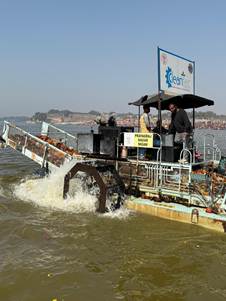Ministry of Information & Broadcasting
Mahakumbh 2025: 10-15 Tons of Trash removed daily by Trash Skimmer from Triveni Sangam in Prayagraj
प्रविष्टि तिथि:
11 FEB 2025 10:33PM by PIB Delhi
The Prayagraj Municipal Corporation is actively working to realize Prime Minister Shri Narendra Modi's vision of Swachh Bharat, and keep the Triveni Sangam clean and pure. For this, trash skimmer machines have been installed, which remove 10 to 15 tons of waste daily from the Ganga and Yamuna rivers.

The preparations for the world's largest event, the Mahakumbh, began nearly four years ago when the trash skimmer machine was installed. Initially, this machine removed 50-60 quintals of waste daily. After observing its effectiveness, the Prayagraj Municipal Corporation bought another machine about two years ago, which doubled the pace of cleaning the rivers.
Machine Capacity: 13 Cubic Meters
The machines cleaning both rivers have a capacity of 13 cubic meters and cover a 4 km area in the river, from the Sangam to the boat club and beyond. These machines collect floating flowers, garlands, paper plates, incense wrappers, plastic, coconuts, clothes, etc., from the surface.
Disposal of Waste at a Single Location
Municipal Corporation officials state that the waste collected by the machines is disposed off at a designated spot near Naini. From there, it is transported daily by trucks to a plant located in Baswar, where the waste is separated into coconuts, plastic, and other materials. The plastic is sent for recycling, while other usable materials are turned into compost.
What is a Trash Skimmer Machine?
- A trash skimmer is used to collect floating waste from the surface of the water. This machine is employed to clean rivers, ports, and seas.
- It collects plastic, bottles, religious waste, clothes, metal items, offerings, dead animals and birds, etc.
- It also helps in removing water weeds (water hyacinth).
How Does a Trash Skimmer Work?
- The machine has gates on both sides, with conveyor belts inside them. These gates hydraulically close to trap the waste. Once collected, the waste is transferred onto the conveyor belt.
- From there, it moves to an unloading conveyor belt, where it is disposed of.
*****
AD/VM
(रिलीज़ आईडी: 2102069)
आगंतुक पटल : 1015